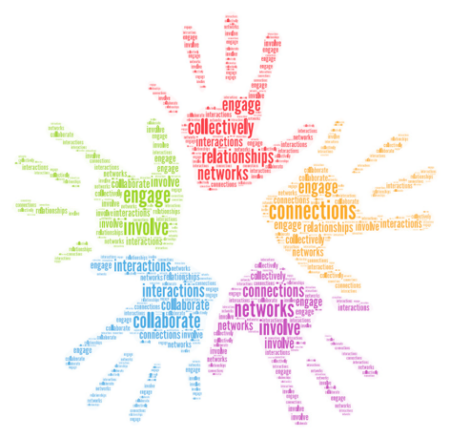Home News & Views Making connections
Making connections
Kate Sanders, FoNS Practice Development Facilitator
27 March 2018

I started the day with the thought that I needed to write a blog – it is probably my turn after all! So, I went in search of inspiration. I found myself catching up with Module 1 in the School for Change Agents which is entitled: Change starts with me. It raised the issue of power and how change agents work within the concept of ‘new power’, which is built on connections and relationships. This resonates with some of the messages from Julian Stodd’s writing on Social Leadership. He advocates the importance of building and strengthening social ties, enabling us to tap into the often unheard wisdom within organisations by connecting, sharing and building trust.
 Several times during the module I heard the message: ‘effective change agents do not work on their own’, they work together, with others. Of course this makes sense; we are social beings after all, and we work in complex systems and therefore can’t and shouldn’t expect to push a boulder up a hill single handed. And yet, it feels that for many of the people that we work with e.g. ward managers, team leaders, care home managers, nurse specialists etc., they come with both experience and expectation of taking responsibility for and undertaking change largely on their own. Why is this? Is it because organisations place the greatest emphasis on the outcomes to be achieved, rather than the processes by which we achieve them? Is this because they don’t believe that they have the time to engage others or perhaps the knowledge, skills and confidence to work in a more inclusive way?
Several times during the module I heard the message: ‘effective change agents do not work on their own’, they work together, with others. Of course this makes sense; we are social beings after all, and we work in complex systems and therefore can’t and shouldn’t expect to push a boulder up a hill single handed. And yet, it feels that for many of the people that we work with e.g. ward managers, team leaders, care home managers, nurse specialists etc., they come with both experience and expectation of taking responsibility for and undertaking change largely on their own. Why is this? Is it because organisations place the greatest emphasis on the outcomes to be achieved, rather than the processes by which we achieve them? Is this because they don’t believe that they have the time to engage others or perhaps the knowledge, skills and confidence to work in a more inclusive way?
As my initial search for inspiration continued, I came across the announcement of an upcoming Skills for Care publication called: Your wellbeing really does matter [this publication is no longer available]. The publication is in recognition of the importance of the wellbeing of registered care home managers and care workers and it will introduce ‘5 Ways to Wellbeing – Connect, Be active, Take notice, Keep learning and Give’. Here again my attention was drawn to the acknowledgement of connection as something that matters, this time in relation to wellbeing. This is perhaps not surprising for me as I am in the thick of my doctoral studies which relate to wellbeing in nursing and my hunch that this is enhanced when nurses experience a sense of being in relationship with patients and colleagues.
These resources then triggered me to reflect on the recent stories of ‘connection’ that I have experienced or heard about. Here is a flavour of these:
- About 10 days ago, Theresa and I met with a group of fifteen care home staff (from five care homes across England) as part of our Teaching Care Homes programme. A key feature of their evaluation feedback was how much they had valued networking with others from the care sector, being able to share and to learn with and from each other. They all left with energy, enthusiasm and action plans!
- I met with a care home manager recently who shared his experience of leading a project to improve the experience of transfers between care homes and hospitals. Some 18 months on from the start, he was delighted to talk about the successes in implementing the red bag scheme and how they had been achieved. What was interesting about the discussion however, was the recognition that the red bag itself was just a tool. Key to the successful implementation had been the development of relationships. Time and energy had been committed to bringing together key stakeholders e.g. care home staff, members of the ambulance service, ward managers, the discharge planning team, and representatives from the CCG. Meeting together had created the opportunity to understand the many perspectives and to work collectively to find solutions
- Last week I had a telephone conversation with a practitioner, someone I have been connecting with regularly. This is an opportunity for them to have a critical conversation about trying out new ways of working, to celebrate their successes, to share their learning, to pose questions and explore possibilities. One of the discussions started with the idea of ‘doing it alone’ but it ended with a plan to involve and engage others. This recognises the ideas of others and the possibilities for ownership. As well as tangible outcomes in terms of definitive actions, I recognise that conversations such as these, which offer opportunities for mutual learning, also enhance my sense of well-being
- Two recent stories from practice centre around a pot of tea and its power to facilitate connection, interaction and understanding. In a leadership development programme, one team leader talked about the impact of 12-hour shifts on the opportunity for staff to be together. She had therefore introduced a pot of tea at handover, as a means of giving staff permission to sit a while, to talk and build relationships. Another shared how, being new, she sensed some underlying tensions within the team which did not seem to be spoken about. She also brought a pot of tea to handover and suggested to the team that they stayed and enjoyed a cup of tea together, whilst exploring the team dynamics. The tea and the conversation flowed, and resolutions were found.
To summarise, I see connecting as a way of:
- Understanding what matters
- Tapping into the knowledge and experiences of others
- Creating energy and enthusiasm
- Enhancing wellbeing.
What ideas for enhancing connections do you have?
Comments are closed.

